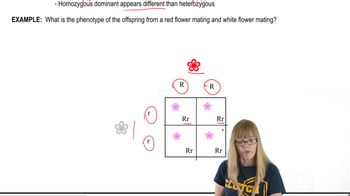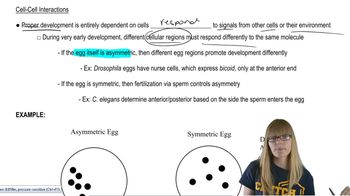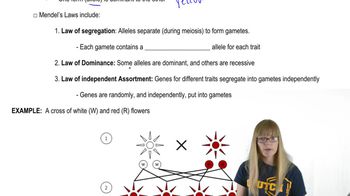Table of contents
- 1. Introduction to Genetics51m
- 2. Mendel's Laws of Inheritance3h 37m
- 3. Extensions to Mendelian Inheritance2h 41m
- 4. Genetic Mapping and Linkage2h 28m
- 5. Genetics of Bacteria and Viruses1h 21m
- 6. Chromosomal Variation1h 48m
- 7. DNA and Chromosome Structure56m
- 8. DNA Replication1h 10m
- 9. Mitosis and Meiosis1h 34m
- 10. Transcription1h 0m
- 11. Translation58m
- 12. Gene Regulation in Prokaryotes1h 19m
- 13. Gene Regulation in Eukaryotes44m
- 14. Genetic Control of Development44m
- 15. Genomes and Genomics1h 50m
- 16. Transposable Elements47m
- 17. Mutation, Repair, and Recombination1h 6m
- 18. Molecular Genetic Tools19m
- 19. Cancer Genetics29m
- 20. Quantitative Genetics1h 26m
- 21. Population Genetics50m
- 22. Evolutionary Genetics29m
2. Mendel's Laws of Inheritance
Mendel's Experiments and Laws
Problem 3b
Textbook Question
For the retinal cancer retinoblastoma, the inheritance of one mutated copy of RB1 from one of the parents is often referred to as a mutation that produces a 'dominant predisposition to cancer.' This means that the first mutation does not produce cancer but makes it very likely that cancer will develop.
Using RB1⁺ for the normal wild-type allele and RB1⁻ for the mutant allele, identify the genotype of a cell in a retinoblastoma tumor.
 Verified step by step guidance
Verified step by step guidance1
<span>Step 1: Understand the genetic basis of retinoblastoma. Retinoblastoma is a type of cancer that is often associated with mutations in the RB1 gene. Individuals with retinoblastoma typically inherit one mutated allele (RB1⁻) from a parent, which predisposes them to cancer.</span>
<span>Step 2: Recognize the concept of 'two-hit hypothesis.' According to this hypothesis, both alleles of a tumor suppressor gene like RB1 must be inactivated for cancer to develop. In hereditary retinoblastoma, individuals are born with one mutated allele (RB1⁻) and one normal allele (RB1⁺).</span>
<span>Step 3: Determine the genotype of a cell in a retinoblastoma tumor. For a tumor to form, the second allele must also become mutated. Therefore, the genotype of a cell in a retinoblastoma tumor would be RB1⁻/RB1⁻, indicating that both alleles are mutated.</span>
<span>Step 4: Consider the implications of this genotype. The loss of function of both RB1 alleles leads to uncontrolled cell division, which is a hallmark of cancer.</span>
<span>Step 5: Summarize the genetic change. In retinoblastoma tumors, the genotype RB1⁻/RB1⁻ reflects the complete loss of functional RB1 protein, which is crucial for regulating the cell cycle and preventing tumor formation.</span>
Recommended similar problem, with video answer:
 Verified Solution
Verified SolutionThis video solution was recommended by our tutors as helpful for the problem above
Video duration:
1mPlay a video:
Was this helpful?
Key Concepts
Here are the essential concepts you must grasp in order to answer the question correctly.
Dominant Inheritance
Dominant inheritance refers to a pattern where a single copy of a mutated gene is sufficient to express a trait or condition. In the case of retinoblastoma, inheriting one mutated RB1 gene (RB1⁻) from a parent increases the likelihood of developing cancer, even though the individual may not show symptoms until a second mutation occurs.
Recommended video:
Guided course

Variations on Dominance
RB1 Gene Function
The RB1 gene encodes a protein that is crucial for regulating the cell cycle and preventing uncontrolled cell growth. When this gene is mutated, its ability to control cell division is compromised, leading to an increased risk of tumor formation, particularly in retinal cells, which can result in retinoblastoma.
Recommended video:
Guided course

Functional Genomics
Genotype of Tumor Cells
In retinoblastoma tumors, the genotype typically reflects the loss of function of both RB1 alleles. A common genotype for tumor cells would be RB1⁻/RB1⁻, indicating that both copies of the RB1 gene are mutated, which is necessary for the development of the cancerous phenotype in the retinal cells.
Recommended video:
Guided course

Cell-cell interactions

 8:06m
8:06mWatch next
Master Mendel's Experiments with a bite sized video explanation from Kylia Goodner
Start learningRelated Videos
Related Practice



